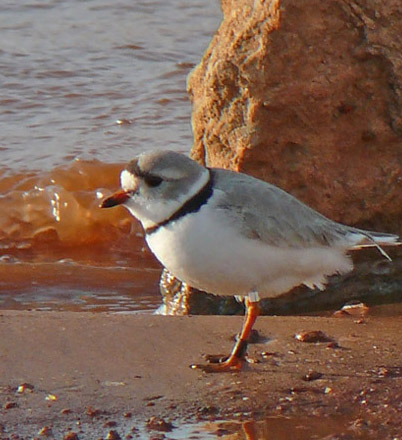
We usually see the Piping Plover (Charadrius melodus), an endangered species, as spring and fall migrants in central Oklahoma, at Lakes Hefner and Overholser; our lakeshore beaches provide migration habitat for them. Migration through central and eastern Oklahoma has been “recorded chiefly from July 14 to October 12, and from April 18 to May 15” (Sutton, 1967, Oklahoma Birds). This is a species that is always rare enough to be fun to see, as well as encouraging, because of its endangered species status. Another endangered species we similarly host only during migration is the Whooping Crane. A good number of their total population usually stops at the Great Salt Plains National Wildlife Refuge each spring and fall.
Piping Plover identification is usually quite satisfying because there are enough clear-cut points that it usually does not leave you with the impression of relying too heavily on “mushy” points, as is the case for some “peep” sandpiper IDs. This plover has one breast band or partial breast band eliminating the Killdeer, which has two breast bands. It has legs that remain yellow all year long, eliminating the Snowy Plover, which has grayish or blackish legs. The Piping Plover’s back color is the color of dry sand, and this eliminates the Semipalmated and Wilson’s plovers, which have a back the color of wet sand (OK, so this is a little “mushy). In breeding plumage, the Piping Plover has a stubby yellow bill with a black tip that helps firm up the identification (in winter plumage the bill can be all black, but stays stubby).
The species nests in two widely separated places: along the Atlantic coast from North Carolina northward into southern Canada, and in the interior North America “on salt flats around lakes and rivers on northern prairies” (Kaufman, 2000, Field Guide to Birds of North America). No doubt this latter population is where most of the birds found migrating through Oklahoma come from. The species is “[listed as endangered in Canada and the inland United States, as well as “threatened along [the U.S. Atlantic] coast” (Internet, The Cornell Laboratory of Ornithology, All About Birds). It has become endangered primarily because of incompatible human uses of shorelines where the plover tries to nest—people, pets, 4-wheelers and the like disrupting them along beaches.
The nesting range of the interior plovers has been given as southward to Nebraska, but a number of years ago, for several years, it nested southward to Lake Optima, in Texas County, Oklahoma. I have never quite understood why it has not been found nesting at the Great Salt Plains National Refuge in northern Oklahoma on occasion, but so far as I know, that is the case; I think it should be watched for there, where many of the similar Snowy Plovers are found nesting.
As for “odd” records, there is one of a single Piping Plover on 24 June 1961 along the Canadian River near Norman; it was seen in the vicinity of nesting Snowy Plovers and Least Terns. I once found a male Piping Plover doing courtship flights during the middle of the breeding season at a sand pit adjacent to the Cimarron River north of Guthrie, in Logan County. He would fly up into the air maybe 25 feet, then slowly descend, doing graceful “butterfly” wingbeats, until finally settling back on the sand. I saw him doing this on several days, but alas, no mate ever showed up. If you get a chance to witness this behavior, it is quite a remarkable performance.
In winter the species can be found along the Atlantic and Gulf coasts from the Carolinas to the Yucatan Peninsula of Mexico, some spreading into the Bahamas and West Indies.
